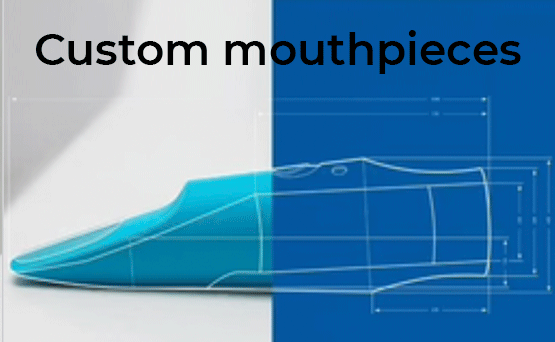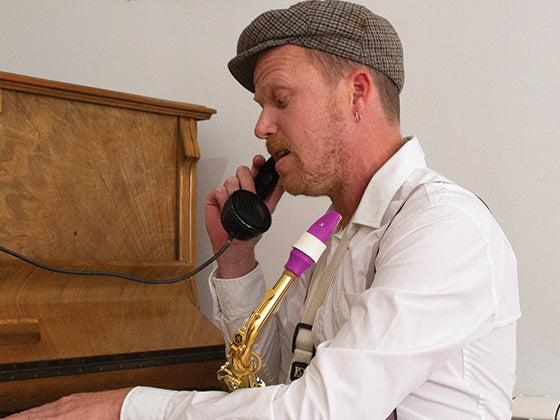The clarinet mouthpiece is the most important part of the clarinet when it comes to acoustics and tone color. It connects the musician to the rest of instrument, and it's where the sound is shaped.
The clarinet mouthpiece as part of the instrument

The clarinet mouthpiece is located at the upper end of the instrument. Along with the clarinet reed and clarinet ligature, it allows the musician to produce sound.
Placement of the clarinet mouthpiece
The clarinet mouthpiece fits into the bore, in the baril to be precise. The lower part of the mouthpiece, the shank, can be covered with cork to allow the pieces to fit together tightly. Some mouthpieces, like the Syos clarinet mouthpiece, are fitted with silicone band seals which serve the same purpose.

Clarinet mouthpiece anatomy
The clarinet mouthpiece is a masterpiece of complex geometry. It is the most important piece when it comes to sound production. Its internal geometry is responsible for variation in tone quality and the comfort of play for the musician.
The different parts of the clarinet mouthpiece
Here is a diagram of the different parts of a clarinet mouthpiece:

The most important parts are:
- The mouthpiece chamber, which varies in size and shape (round, square, horseshoe...)
- The tip opening, which corresponds to the distance between the reed and the mouthpiece tip
- The mouthpiece facing curve, the length of the mouthpiece that curves away from the table
- The mouthpiece baffle which is straight in most clarinet mouthpieces, but can vary in shape, particularly in jazz and klezmer clarinet mouthpieces.
The b-flat clarinet mouthpiece
The most popular clarinet is the b-flat clarinet (also known as the soprano clarinet). The most well-known b-flat clarinet mouthpiece brands are Vandoren, Selmer, Buffet Crampon, Pomarico, and Syos.
The bass clarinet mouthpiece
Bass clarinet is widely used in classical music as well as in modern musics, such as jazz and klezmer. The bass clarinet mouthpiece is wider and longer than the b-flat clarinet mouthpiece.

The bass clarinet mouthpiece fits into the instrument, just as the b-flat clarinet mouthpiece with cork or silicone seals on the shank. However, it does not fit into the baril but rather into the neck, just as saxophone mouthpieces. The bass clarinet mouthpiece anatomy is the same as that of the soprano clarinet, however the tip openings are generally wider.
Materials used to make clarinet mouthpieces
Soprano and bass clarinet mouthpieces can be made out of various materials. For a clarinet mouthpiece, the material has no influence on the sound. There are therefore many options. The most popular materials are:
Wood and ivory
Clarinet mouthpieces were originally made out of wood and ivory. However,nowadays these materials have been replaced by others, such as hard rubber, plastic and crystal.

Hard rubber
Hard rubber is a plastic resin made from natural rubber mixed with 20 to 40% sulfur, then subjected to intense heat (a process called vulcanization). Hard rubber was the most commonly used material for clarinet mouthpieces in the 20th century. It is a hard and brittle material (not to be dropped on the ground), and it is comfortable for the mouth.

"Crystal"
Some more recent clarinet mouthpiece brands make crystal mouthpieces (actually made of glass). They are usually easier to clean, but are as brittle as hard rubber mouthpieces. The feeling in mouth is also slightly different. The most famous crystal mouthpieces brand is Pomarico.

SCAL3D
Until 2025, Syos mouthpieces were crafted in SCAL3D, a material developed with French research labs. It was certified non-toxic, impact-resistant, and specially designed for 3D printing, making it possible to create unique and precise custom geometries.

UPSCAL3D
Since September 2025, Syos mouthpieces are made in UPSCAL3D, our new proprietary material developed after more than two years of research. UPSCAL3D preserves all the benefits of SCAL3D while improving durability and resistance to aging. It matches the hardness of hard rubber, the traditional benchmark, but with none of its drawbacks. Fully FDA certified, UPSCAL3D guarantees complete safety and comfort in the mouth, while being perfectly optimized for 3D printing. Thanks to this innovation, Syos continues to offer clarinetists reliable, colorful, and highly customizable mouthpieces designed to last.
For more details, read our article about the clarinet mouthpiece chamber.













